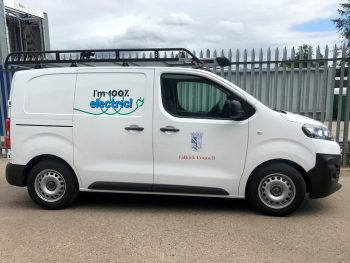Falkirk Council in Scotland has deployed seven electric Citroën ë-Dispatch vans, advancing its plans to build an electric vehicle fleet.

The ë-Dispatch Enterprise vans, supplied in XS body length and with a 50kWh battery, are already in use, supporting essential building maintenance work throughout the council region.
The vans were acquired though Arnold Clark, and Falkirk Council was supported with funding through Transport Scotland’s ‘Switched On Towns and Cities Challenge Fund’ and ‘Switched on Fleet Fund’ schemes.
The council opted for the ë-Dispatch due to its practical range and sizeable load capacity – the van has 6.6m3 of load volume and a payload of up to 1,002kg. Falkirk Council’s vehicles were also converted with a pipe carrier roof rack and plywood lining to provide further functionality.
The vans have a WLTP range of up to 143 miles – the ë-Dispatch is also available with a larger 75kWh battery pack capable of up to 205 miles. Both can be charged at home or on site through a 7kW wallbox, or via rapid charging at speeds of up to 100kW. The later can recharge the battery to 80% of capacity in 30 minutes for the 50kWh variants or 45 minutes for 75kWh versions.
The electric vans also benefit from low running costs; analysis conducted by Citroën UK found that the total cost of ownership for a new ë-Dispatch could be less than half that for an equivalent diesel van. And the zero-emission Citroën ë-Dispatch is exempt from the Congestion Charge and ULEZ/Clean Air Zones.
Laura Campbell, fleet co-ordinator for Falkirk Council, said: “The introduction of new Citroën ë-Dispatch to our fleet will give us the confidence that we can undertake our services in an environmental and cost-effective way, without any compromise to practical necessities like load space and vehicle range.”
Citroën UK fleet director Scott Westerby added: “A key model in our electric vehicle range, new ë-Dispatch is an ideal solution for public and private sector operators alike, as it strikes a perfect balance between maintaining all the capacity of non-electric versions, and offering zero tailpipe emissions with significant whole-life cost benefits.”

